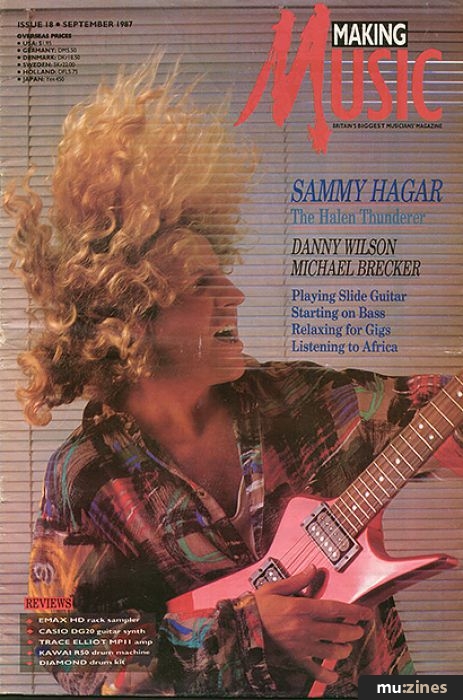Magazine Archive
Home -> Magazines -> Issues -> Articles in this issue -> View
Article Group: | |
Kawai R50 | |
Digital Drum MachineArticle from Making Music, September 1987 | |
Paul Colbert decides that the smaller brother of the R100 digital drum machine is a very clever piece of work.

WE SAY
A small brother to Kawai's R100 digital drum machine, but hardly a midget in facilities, and obviously thought out by someone with a shrewd grasp of what the less than wealthy musician needs.
The R100 had touch-sensitive pads, replaced on the 50 by smaller non-sensitive tabs (though still velocity programmable over MIDI). And out goes the alpha numeric pad and control buttons which sped you through the R100's features. The 50 makes do with cursors and double entry switches, but it has gained three electronic tricks to help change the sound — especially handy for those of us without much outboard gear. There's a built in flanger, an automatic double tracking delay (very fast slapback echo), and three gates which mimic, however crudely, the fast cut-off on reverberant sounds.
All of the R50's ten pads are assignable so you can build your own front panel 'kit' from any of the 24 sampled sounds, positioning them on whichever pad you wish. Since the R50 can remember tunings, pan positions, volume levels and accents, one sample can make several appearances within a kit.
Patterns can be written in step or real time, with up to 99 bars per pattern (and in strange multiple times — 4/4, 7/8, 19/8, up to 99/16). Error correction runs from 1/16 notes to a detailed 1/96, though the onboard Swing function will pull beats away from their mathematically precise positions to loosen a pattern's feel. Small amounts are more convincing than dollops.
Songs are built by calling up desired patterns with the cursor and punching them into a list, with plenty of copy, multiply, insert and delete functions to simplify matters and save memory. Each song has a maximum of 255 parts, but you can link several songs together.
The sounds have a good degree of fidelity (identical to the R100's I think). The ride and crash cymbals wouldn't win too many prizes for duration — they ting nicely, but decay fairly fast. Still it's useful to have two rides — one light and jazzy struck on its rim, the other a rockier bell tone. The second bass drum and second snare are both soaked in reverb for that reunion gig in the Budokan. Handy, and all the essential ground is covered, if a little unadventurously.
But variety is waiting just around the circuit board. Delay will send stereo cymbals flying past both sides of your head, flange can add a resonant peak to the tone or a fully fledged woosh depending on its strength, and gate, er, certainly cuts things short but to me seemed most effective at imitating backwards cymbals.
Lastly, the R50 is eight sound polyphonic even when the same sample is assigned to different pads: very unusual that. You can have three different tunings of one ride cymbal, hit all three pads at the same instant and hear all three tunings.
A very efficient piece of work dragging the maximum use from the noises on board. The very clever application of a few simple tricks really stretches the basic sound, and overall it's easy to program if not as fast and luxurious as its bigger associate. Some of the demonstration songs programmed into the R50 make me think Kawai have a rap fan on the staff somewhere — all those high, dry bass drums and gated off snares. Nice to know you can do it when you want.
KAWAI R50 £325
Kawai UK Ltd, (Contact Details).
THEY SAY
PATTERNS 100
SONGS 10
ERROR CORRECT 1/6, 1/12, 1/24, 1/48, 1/96
PADS 10 (fully assignable)
PROGRAMMING Accent, Pan, Tune, Level, Level, Gate, Delay, Flange.
SOCKETS Headphone, Stereo outputs plus one individual output assignable to any drum, MIDI in/out, Tape in/out, Footswitch
Also featuring gear in this article
Kawai R50 - Digital Drum Machine
(MT Sep 87)
Kawai R50 Drum Machine
(MT Jun 87)
Kawai R50 Drum Machine
(SOS Sep 87)
Browse category: Drum Machine > Kawai
Featuring related gear
Kawai R100 drum machine
(MM May 87)
Kawai R100 Drum Machine
(SOS Jun 87)
Browse category: Drum Machine > Kawai
Publisher: Making Music - Track Record Publishing Ltd, Nexus Media Ltd.
The current copyright owner/s of this content may differ from the originally published copyright notice.
More details on copyright ownership...
News And Reviews
Review by Paul Colbert
Help Support The Things You Love
mu:zines is the result of thousands of hours of effort, and will require many thousands more going forward to reach our goals of getting all this content online.
If you value this resource, you can support this project - it really helps!
Donations for May 2024
Issues donated this month: 0
New issues that have been donated or scanned for us this month.
Funds donated this month: £0.00
All donations and support are gratefully appreciated - thank you.
Magazines Needed - Can You Help?
Do you have any of these magazine issues?
If so, and you can donate, lend or scan them to help complete our archive, please get in touch via the Contribute page - thanks!










